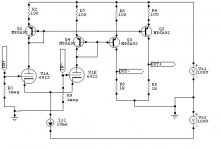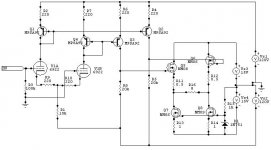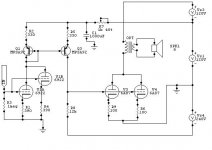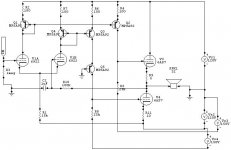I've been building amps using current mirrors since I learned about them in college about 15years ago. I first tried it b/c I didn't have a voltage supply with high enough voltage for the tube, and as a student, didn't have money to buy another transformer.
I liked the sound of the first preamp I built with a mirror, fast and accurate to my ears. Since the output can be loaded with anything, the volume was adjusted by various resistors via a rotary switch and the signal taken out without passing thru the resistors. After that, almost all my amps, espescially the VAS stages are like this.
Depending on how u use them, and look at it, they have some very good points.
1. The circuit is DC coupled, no cap in series.
2. The tube being mirrored sees a constant load.
3. The low voltage swing makes Mr.Miller a non-contender. (wideband)
4. The load on the output side can be anything.
5. The load on the output can be terminated at any voltage.
6. The supply is often at a friendlier potential.
7. The current is at max when the output is at max amplitude. (grid drive)
8. Everybody else builds classic circuits, it's nice to be different
Some comments on those points:
Look at the heated discussions about signal capacitors, and point 1 gets real nice. I dont even want to start another one of those discussions. But is a transistor any better? Well, I think so. Is a choke or CCS with an output cap any better? Well, if u cannot utilize the direct coupling for some reason, and u must have capacitor coupling, there is no reason the mirror is better.
The tube being mirrored sees a contant load, and relative to the plate voltage, we can say the voltage swing on the plate is minute, so it is like a cascode. Do cascodes sound great? Well I think these circuits do, so I guess so. The real benefit in addition to the cascode's wide bandwidth is the output being so flexible as to how it is connected and loaded. The combination of that makes it a good solution.
It is very fast, and in my amps using the low mu 6AS7 it swings +-120volts at over 50kHz with no problems, even with several in parallel. For driving an output tube's grid it also is beneficial that the current is at it's max when the output swings up. (Noninverting).
I have tested various mirror types, wilson mirrors, cascoded outputs, MOSFETs, BJTs, etc. The spectrum analyzer shows near identical performance with all, making me believe the tube is the dominant contributor, so I consider this a hybrid circuit with tube dominance. (And I use the simplest mirrors).
Anyway, before going too far, here are some sample circuits I have built using this topology.
These are simplified schematics, but show how direct the signal path is. I do not bother draw in the grid stoppers or the various power supply components. (The excellent article by Lynn Olson about current loops is a must read when optimizing the supply).
Btw. I found this thread about mirrors which I havent had time to look at yet, but hopefully it is an interesting read. Perhaps tonight with some good wine and and a few good records
http://www.diyaudio.com/forums/solid-state/133018-current-mirror-discussion.html
I liked the sound of the first preamp I built with a mirror, fast and accurate to my ears. Since the output can be loaded with anything, the volume was adjusted by various resistors via a rotary switch and the signal taken out without passing thru the resistors. After that, almost all my amps, espescially the VAS stages are like this.
Depending on how u use them, and look at it, they have some very good points.
1. The circuit is DC coupled, no cap in series.
2. The tube being mirrored sees a constant load.
3. The low voltage swing makes Mr.Miller a non-contender. (wideband)
4. The load on the output side can be anything.
5. The load on the output can be terminated at any voltage.
6. The supply is often at a friendlier potential.
7. The current is at max when the output is at max amplitude. (grid drive)
8. Everybody else builds classic circuits, it's nice to be different
Some comments on those points:
Look at the heated discussions about signal capacitors, and point 1 gets real nice. I dont even want to start another one of those discussions. But is a transistor any better? Well, I think so. Is a choke or CCS with an output cap any better? Well, if u cannot utilize the direct coupling for some reason, and u must have capacitor coupling, there is no reason the mirror is better.
The tube being mirrored sees a contant load, and relative to the plate voltage, we can say the voltage swing on the plate is minute, so it is like a cascode. Do cascodes sound great? Well I think these circuits do, so I guess so. The real benefit in addition to the cascode's wide bandwidth is the output being so flexible as to how it is connected and loaded. The combination of that makes it a good solution.
It is very fast, and in my amps using the low mu 6AS7 it swings +-120volts at over 50kHz with no problems, even with several in parallel. For driving an output tube's grid it also is beneficial that the current is at it's max when the output swings up. (Noninverting).
I have tested various mirror types, wilson mirrors, cascoded outputs, MOSFETs, BJTs, etc. The spectrum analyzer shows near identical performance with all, making me believe the tube is the dominant contributor, so I consider this a hybrid circuit with tube dominance. (And I use the simplest mirrors).
Anyway, before going too far, here are some sample circuits I have built using this topology.
These are simplified schematics, but show how direct the signal path is. I do not bother draw in the grid stoppers or the various power supply components. (The excellent article by Lynn Olson about current loops is a must read when optimizing the supply).
Btw. I found this thread about mirrors which I havent had time to look at yet, but hopefully it is an interesting read. Perhaps tonight with some good wine and and a few good records
http://www.diyaudio.com/forums/solid-state/133018-current-mirror-discussion.html
Here is my OTL used in this nerdy demo:
YouTube - OTL project
YouTube - OTL project
Attachments
So that shows some various amps using mirrors. I'd like your views on mirrors and perhaps inputs from those of you who have tried them. I will read the mentioned thread when I have time, so this thread is very likely redundant, in that case sorry, but I am bored at the moment so start silly threads. Stuck at work with stuff overdue...really shouldn't be here at all today;(
My next project is coming up, and perhaps I will try something totally different for a change. I must say Lynn Olson's projects are very tempting indeed.
Oh, anyone have the schems on Tim Mellow's OTL? I like to read anything on the OTL wagon, but his OTL I cannot seem to find info on, other than that is is real simple. I like it simple
My next project is coming up, and perhaps I will try something totally different for a change. I must say Lynn Olson's projects are very tempting indeed.
Oh, anyone have the schems on Tim Mellow's OTL? I like to read anything on the OTL wagon, but his OTL I cannot seem to find info on, other than that is is real simple. I like it simple
So this idea came to me today to look up tube circuits using current mirrors as they are a standard part of building a high end SS amplifier in 2021 and there is no reason to not be using them in tube circuits (are there still people who live in the world where they wouldn't use the best of all options no matter the age of the technology?).
I was wondering if you've played any more with this in the past few years. I've seen some discussions on tube cad around using current mirrors for biasing, LTP and output tube setups.
As an amateur, I'm wondering if this could be used with a parallel triode for an preamp to reduce noise and increase gain.
I was wondering if you've played any more with this in the past few years. I've seen some discussions on tube cad around using current mirrors for biasing, LTP and output tube setups.
As an amateur, I'm wondering if this could be used with a parallel triode for an preamp to reduce noise and increase gain.
Broskie has a number of current mirror ideas including 'inverted current mirrors'.
I've just discovered my old m-audio firewire midi/dac.. it occurred to me the small box would be a great donor for a simple tube + solid state mini amp as it has all the I/O connections already present and a nice metal case.. then I discovered this thread and it adds another piece to the jigsaw. I did think about suggesting a smallest amp competition.
I may add a couple of bits to the BOM for the other amp gut the 'audiophile' unit and run a small tube B9A single ended pre in it. So the thread revival (11 years!) couldn't have come at a better time
gut the 'audiophile' unit and run a small tube B9A single ended pre in it. So the thread revival (11 years!) couldn't have come at a better time 
Although, from a current perspective I assume it doesn't matter if you run as a cathode mirror or an anode mirror (it does for voltage). The cathode would be lower noise as the current will not have passed through the triode.
The resulting mirrored current from a cathode should have less shot noise? but still have harmonics from he tube. I don't know but it's worth trying.
Lots of ideas..
I've just discovered my old m-audio firewire midi/dac.. it occurred to me the small box would be a great donor for a simple tube + solid state mini amp as it has all the I/O connections already present and a nice metal case.. then I discovered this thread and it adds another piece to the jigsaw. I did think about suggesting a smallest amp competition.
I may add a couple of bits to the BOM for the other amp
Although, from a current perspective I assume it doesn't matter if you run as a cathode mirror or an anode mirror (it does for voltage). The cathode would be lower noise as the current will not have passed through the triode.
The resulting mirrored current from a cathode should have less shot noise? but still have harmonics from he tube. I don't know but it's worth trying.
Lots of ideas..
Last edited:
One can make current mirrors using just tubes also.
The long lost linear gain stage
There is also the "Voltage Mirror" circuit, better known lately as the Aikido input stage.
https://www.diyaudio.com/forums/tubes-valves/172771-history-fidelity-amplifiers-3.html#post2659643
The long lost linear gain stage
There is also the "Voltage Mirror" circuit, better known lately as the Aikido input stage.
https://www.diyaudio.com/forums/tubes-valves/172771-history-fidelity-amplifiers-3.html#post2659643
- Home
- Amplifiers
- Tubes / Valves
- Current mirror circuits



